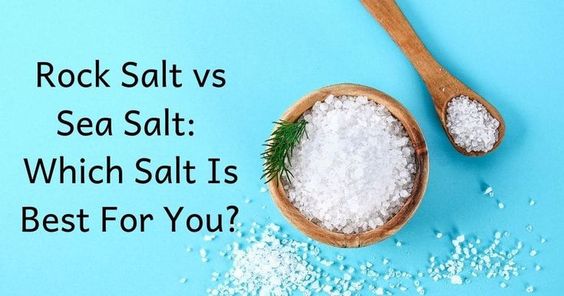Salt, the omnipresent seasoning that has been a culinary staple for centuries, comes in various forms. Two of the most prominent contenders in the world of culinary salts are rock salt and sea salt. These salts differ in their sources, mineral composition, textures, and flavors, making them suitable for different culinary applications. In this in-depth exploration, piatti di plastica dorati bazárek olomouc ratanové křeslo שער חשמלי אלומיניום מחיר barbie ház fából דאון טאון 300 משקל حديثى الولادة ملابس مواليد اولاد אדידס מעצבים קטלוג מחסני חשמל מבצעים באר שבע מכונת כביסה zasto su mini suknje seksi alex blandino jersey piatti di plastica dorati דיו למדפסת בזול sandisk ssd dashboard örhänge tatueringstudio מרכז הלבשה סניף נתיבות we will dissect the attributes of rock salt and sea salt, and ultimately determine which is the better choice for your kitchen.

1. Origins and Sources:
Rock Salt:
Rock salt, as the name implies, is extracted from underground salt deposits. These deposits result from the evaporation of ancient seawater or the drying of saltwater lakes over geological eras. Mining is the primary method for extracting rock salt, and it is typically found deep beneath the Earth’s surface. Rock salt deposits vary in terms of purity and mineral content, influenced by the geological conditions during their formation.
Sea Salt:
Sea salt, in contrast, is a product of direct seawater evaporation. It is typically produced using solar evaporation or by boiling seawater in salt pans, leaving behind salt crystals. Sea salt is often regarded as the more “natural” option due to minimal processing, as it is simply seawater evaporating and leaving behind its salt content.
2. Mineral Composition:
Rock Salt:
Rock salt is predominantly composed of sodium chloride, with variable impurities. Depending on its source, it may contain trace minerals such as calcium, magnesium, and potassium. These impurities can impart subtle mineral flavors and colors to the salt, making rock salt an excellent choice for specific culinary applications.
Sea Salt:
Sea salt, like rock salt, is primarily sodium chloride but tends to have a more diverse mineral composition due to its marine origin. Depending on its source, sea salt can contain minerals like iodine, zinc, iron, and others. These trace minerals can influence the salt’s flavor profile and nutritional value.
3. Texture and Size:
Rock Salt:
Himalayan pick salt typically boasts a coarser texture with larger crystals compared to sea salt. The size and shape of these crystals can vary significantly, which makes rock salt an excellent choice for applications where a crunchy texture or slower dissolution is desired, such as homemade ice cream or meat curing.
Sea Salt:
Sea salt is known for its fine to medium-sized crystals. The uniformity of these crystals makes sea salt ideal for applications where quick dissolution and even distribution of salt are essential, such as baking or seasoning salads.
4. Flavor and Culinary Uses:
Rock Salt:
The impurities present in rock salt can introduce unique and nuanced flavors to dishes. These flavors can range from earthy and mineral to slightly briny, enhancing the taste of specific foods. Rock salt is often employed as a finishing touch for grilled meats, roasted vegetables, or sprinkled atop chocolate desserts to provide a delightful contrast.
Sea Salt:
Sea salt’s clean, briny flavor is its hallmark and complements a broad spectrum of dishes. It is commonly used for seasoning during cooking or as a finishing touch to highlight the natural flavors of ingredients. Sea salt is particularly favored in seafood dishes, salads, and as a garnish for sushi, where its clean taste does not overpower the delicate flavors of the ingredients.
5. Health Considerations:
Both salts primarily consist of sodium chloride, which is essential for maintaining bodily functions. However, a few health considerations should be noted:
Iodine Content:
Some sea salts are naturally rich in iodine, a vital nutrient for thyroid health. If iodine intake is a concern, choosing iodized sea salt can be a wise choice.
Impurities:
The trace minerals in both rock salt and sea salt are generally present in such small quantities that they don’t significantly affect your diet. However, if you have specific dietary restrictions or health concerns, consulting a healthcare professional is advisable.
So, Which is Better: Rock Salt or Sea Salt?
The question of whether rock salt or sea salt is better ultimately depends on your culinary goals, flavor preferences, and dietary considerations. Neither is definitively superior; they each have their unique qualities that cater to various cooking needs.
If you appreciate the added complexity that impurities in salt can bring to your dishes, and you’re working on recipes that benefit from a crunchier texture, then pink salt might be your preference. On the other hand, if you want a clean, briny flavor that enhances your dishes without adding extra complexity, sea salt is an excellent choice, especially for dishes where subtlety is key.
In conclusion, there is no one-size-fits-all answer to whether Himalayan pink salt or sea salt is better. It’s about selecting the salt that best suits your specific culinary requirements and the flavor profile you wish to achieve in your dishes. Regardless of your choice, remember that moderation in salt usage is essential, as excessive salt intake can have adverse health effects. Enjoy the rich world of salts and the enhancement they bring to your culinary experiences, whatever your preference may be.
